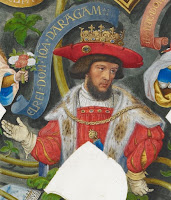Couching is described in Greek and Sanskrit documents. It involves pushing the cloudy lens away from the pupil and into the interior of the eyeball, allowing more light to enter. This was done by inserting a thin sharp needle into the eye through the pupil and, well, simply pushing the lens until it is no longer blocking the light. This was done, of course, without access to anesthetics.
The result was more light, but the light was no longer being focused. The client's world was blurry—assuming the client was not rendered completely blind by damage to the eyes or killed by infection.
Roman artifacts found in the British Isles suggest that the technique was introduced there during the Roman occupation, and perhaps survived throughout the early Middle Ages, although we know of no cases prior to the 1560s.
Physicians and surgeons elsewhere knew of it. John II of Aragon went blind from cataracts by the time he was 70. A physician in his employ, a Jew named Abiathar Crescas, performed couching in September 1468 and restored his sight—or what there was available considering the lack of a functioning lens. John lived until the age of 80.
John's son, Ferdinand, would later, along with his wife, Isabella of Castile, expel all Jews from Spain. This was a major change in policy, since Jews had been prominent in the Court of Aragon. Tomorrow we'll look at the relationship between Aragon and Jews.


